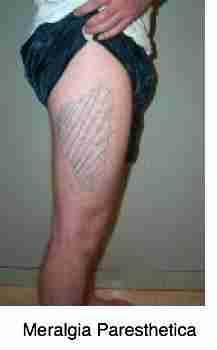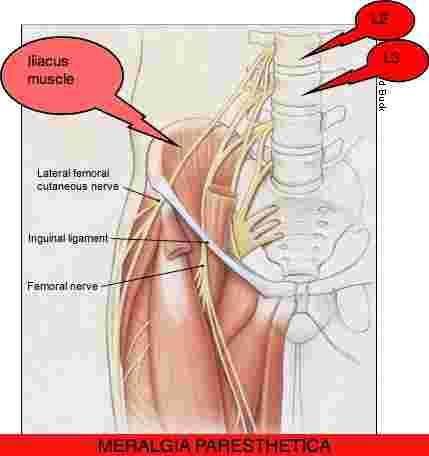Romo Chiropractic
Meralgia Paresthetica
- posted: Jan. 26, 2011
- Chirorpactic, Bulging Disc Herniation Spinal Decompression, To Your Health , Neck Pain, Headaches, Wellness, Awareness, Kids Children, Holiday, Back Pain, Spinal Decompression Therapy, Concussion, Chiropractic Adjustment, Massage

Meralgia paresthetica is a painful condition attributed to entrapment or injury to the lateral femoral cutaneous nerve at the site where the nerve leaves the pelvis. The patient with meralgia paresthetica may complain of a dull ache, itching, numbness, tingling, or burning sensation over the lateral and anterolateral thigh.1-6 The pain associated with this condition may vary in intensity from mild to very severe and frequently occurs following activity with relief following rest. The lateral femoral cutaneous nerve originates from the posterior division of the L2 and L3 nerve levels and is a pure sensory nerve.1,6 Following emergence from the intervertebral foramina of L2 and L3, the nerve traverses the abdomen, first making an appearance at the lateral border of the psoas muscle, and then passing obliquely across the iliacus muscle toward the anterior superior iliac spine. The nerve then exits the pelvis just medial to the anterior superior iliac spine by traversing the fibers of the inguinal ligament.1 The nerve is tightly surrounded by the tendinous fibers of the inguinal ligament at this point and makes a right-handed bend to change direction from a horizontal course in the pelvis to a more vertical course in the lateral and anterolateral thigh.1,3 Various hypotheses have been formulated for the cause of this condition based on the anatomical relationship between the lateral femoral cutaneous nerve and the structures associated with the inguinal region:6
- The nerve may be angulated or compressed against a sharp edge of fascia as it pierces the iliac fascia prior to exiting the pelvis beneath the inguinal ligament.
- The nerve may be subjected to friction where it is wedged between the attachment of the inguinal ligament with the ASIS.
- The nerve may pass through the tendinous fibers of the inguinal ligament and be pinched at this site.
- The nerve may be compressed as it crosses the iliac crest or may be compressed within the substance of the sartorius muscle or tensor fascia lata muscle.
 Numerous factors may contribute to mechanical damage of the lateral femoral cutaneous nerve as it exits under the inguinal ligament, such as obesity, constricting garments or girdles, direct pressure on the thigh in the region of the nerve, postural alterations, or increased demands placed on the abdominal muscles secondary to pregnancy or marching.1,2,3,4,6 Meralgia paresthetica affects men more than women due to possible occupational considerations and may be bilateral in approximately 25 percent of cases.1,2 Clinically, the history may reveal that the pain is potentiated by extension and relieved by flexion, as well as being aggravated by long periods of standing or walking.1,2 Physical examination may reveal a sensory loss taking the form of a reduction of tactile sensation in the distribution of the lateral femoral cutaneous nerve.
Numerous factors may contribute to mechanical damage of the lateral femoral cutaneous nerve as it exits under the inguinal ligament, such as obesity, constricting garments or girdles, direct pressure on the thigh in the region of the nerve, postural alterations, or increased demands placed on the abdominal muscles secondary to pregnancy or marching.1,2,3,4,6 Meralgia paresthetica affects men more than women due to possible occupational considerations and may be bilateral in approximately 25 percent of cases.1,2 Clinically, the history may reveal that the pain is potentiated by extension and relieved by flexion, as well as being aggravated by long periods of standing or walking.1,2 Physical examination may reveal a sensory loss taking the form of a reduction of tactile sensation in the distribution of the lateral femoral cutaneous nerve.
Drawing depicts the sensory field for the lateral femoral cutaneous nerve.
These findings may be accompanied in three-fourth of cases by a tender spot over the inguinal ligament that is two finger widths medial to the anterior superior iliac spine.1,6 Symptoms may also be aggravated by clinically reproducing hip extension through orthopedic tests such as Nachlas' test.1
In diagnosing meralgia paresthetica, care should be taken to rule out intraspinal, retroperitoneal, abdominal, or pelvic pathologies, diabetes mellitus, and L3 disc prolapses.1,3,5,6 Clinically, the L3 disc prolapse may produce alteration of the patellar reflex. In contrast, the reflex will not be altered in meralgia paresthetica.5
Most cases of meralgia paresthetica will respond to conservative care. Modalities that may prove helpful in the treatment of this condition may include ultrasound, electrical stimulation, or transverse friction techniques to break up possible adhesions affecting the lateral femoral cutaneous nerve at the inguinal region. Postural alterations and functional spinal problems should also be addressed in the management of this condition.
References
- Mumenthaler M: Neurology. Thieme-Stratton, Inc., New York, 1983.
- Sunderland S: Nerves and Nerve Injuries, ed 2. Churchill-Livingstone, New York, 1978.
- Turek SL: Orthopedics: Principles and Their Application, ed 4. J.B. Lippincott, New York, 1984.
- Mohr JP: Manual of Clinical Problems in Neurology, ed 2. Little, Brown and Company, Boston, 1989.
- Kramer J: Intervertebral Disc Disease: Causes, Diagnosis, Treatment, and Prophylaxis. Year Book Medical Publishers, Chicago, 1981.
- Bradley WG, Daroff RB, Fenichel GM, and Marsden CD: Neurology in Clinical Practice: The Neurological Disorders. Butterworth-Heinemann, Boston, 1991.
